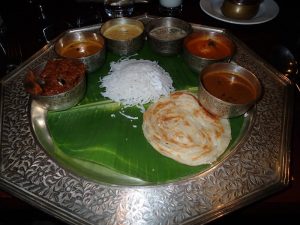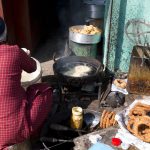 Well, its that time of the year again. Summer holidays are over and I’m all set to leave for another semester of College in the States. No Bombay for the next 4 months and I better have everything I need. As I zip my suitcase the aroma of a dozen intoxicating Indian spices escape to me and I know with the ingredients of my favorite foods intact, home will never be too far away – even in my messy dorm room kitchen in the middle of Lancaster, Pennsylvania! It was true that in my most home-sick moments, “Food, like a loving touch or a glimpse of divine power, had that ability to comfort” (Kolpas, Norman).
Well, its that time of the year again. Summer holidays are over and I’m all set to leave for another semester of College in the States. No Bombay for the next 4 months and I better have everything I need. As I zip my suitcase the aroma of a dozen intoxicating Indian spices escape to me and I know with the ingredients of my favorite foods intact, home will never be too far away – even in my messy dorm room kitchen in the middle of Lancaster, Pennsylvania! It was true that in my most home-sick moments, “Food, like a loving touch or a glimpse of divine power, had that ability to comfort” (Kolpas, Norman).
Food has always been one of the most significant trademarks of my culture, and I too, like most other Indians, have a deep sense of identity embedded in the food I eat. “Aspects of identity, status, gender and sociality are negotiated and performed through the choice of foods, their preparation, display, consumption, and ultimately even their disposal” (‘Food: Culture and Identity’).
There is an “intimate relationship” (Scholliers, Peter) between food and ethnicity and I could not agree more with renowned gastronome, Anthelme Brillat-Savarin when he says, “Dis-moi ce que tu manges, je te dirai ce que tu es” (Tell me what you eat and I will tell you what you are). So let me tell you about what I eat…
Indian cuisine is diverse and every dish has something unique to offer – from the care with which each ingredient is chosen to the absolutely finger-licking end product.
I have lived in Bombay my whole life, and like most other upper middle class Indian families, we too have a chef who lives right by our house and cooks for us 7 days a week. Hailing from north India, he has mastered our individual preferences and my tastebuds are more than accustomed to being tickled by the tinge of mango pickle, a spicy chopped green chilli, or an overdose of “garam masala”. I had been conditioned with these “flavor principles” (‘Food and Culture’), and this made it especially challenging to adapt when I moved to Franklin and Marshall College in the US. Suddenly both the core and complementary foods I began to eat changed and I believe I experienced the “omnivore’s paradox”. As much as I was enjoying the new food I tried, I missed that distinctive flavor that I had grown up with. Freshman year, I found myself eating at our campus quiznos twice a day, adding all five dressings while people looked at me wondering how I could possibly put that down my throat. It was routine – mayonnaise, honey mustard, sweet onion, southwest and vinaigrette.
Even now here in Spain, my host family makes sure there is always enough Tabasco in the cupboard for me to generously shake on my salads before every meal. It sounds strange, but that’s the only way I’m fully satisfied.
An Indian’s diet is so eclectic! Almost every one of the 28 states has its own signature dishes and they have traveled all over the country combining to form one unmatchable national menu. Whether it is the dosas, idlis, sambhar, and uppams of south india, or the pav bhaji, chicken tikka, channa and samosas of the north – most Indian households know just about all the recipes and can recite them in their sleep! This has made me used to eating a large variety of foods even in one single sitting. One can see this reflected in my food habits as I constantly look for an assortment of tastes and get bored easily when the same dishes or even just the same ingredients are repeated.
I was privileged however, to have grown up with all these options. Just as mentioned in the consumer food choice model in ‘Food and Culture’, the kind of food one eats in India is closely related to social status and hence cost. The gap between the affluent and the not so affluent in India is huge and thus the two poles of the spectrum have very different eating habits. Upper class and upper middle class families have domestic help to cook their meals and they tend to eat out at restaurants twice or thrice a week. Middle class families have less access to outside food and exclusive ingredients and thus cook simple meals at home on their own. Finally, the lower class which sadly constitutes a large population of India and live in rural areas either go hungry, or make what they best can out of things they grow on their own farmland. For them, food availability is at the forefront of individual food choice. It bothers me how unfair it is that they are deprived of the many food choices we receive.
Being the heavenly “system of communication” (Barthes, Roland) that it is, food brings us all together in a colorful array of fireworks, clothes, family, friends, and celebration at the time of major festivals. Where food is a way of expressing love, each festival is characterized by special dishes and is more than abundant with them. For example, families and friends exchange mithai on diwali, or feed each other bhang on holi. Large feasts at home are also a common feat.
Since we are used to eating at a pre-decided time with the whole family, I now tend to find a meal incomplete unless I am able to sit down and eat peacefully amidst people I know. Further, having grown up eating fresh and hot served home-cooked meals, I find it hard to eat fast food too many days in a row. It is classic of my culture to have slow cooked food with all its intricacies, taking its own sweet time to prepare, digest and inviting the best sleep thereafter!
Finally, even though I am not particularly religious at all, I find growing up in a country that is has molded my food habits to a great extent. While I voluntarily turned vegetarian about 3 years ago, I have never been a fan of meat like beef, pork, ham etc. I have noticed that for most Hindu Indian families, majority of their meat intake consists solely of chicken and fish and this is what has probably made those tastes slightly unfamiliar to me. While I would try ham or pork once in a while, even as a non-vegetarian they were never a part of my standard diet.
While certain aspects of Indian food are an integral part of who I am, I am in no way averse to experimenting with new flavors. Ever since my arrival in Spain I have constantly been testing my tongue at a number of traditional dishes! It is amazing though how every time I try one of them, my mind immediately begins to tie back and try finding a similarity between the new food and some food or the other from back home. I have found many things in common though, and it gives me an immense sense of security and belonging.
Though particulars might be different, food is said to be “our common ground, a universal experience” (Beard, James). Still, it is fascinating how to each person, the word “food” has an entirely different definition, calls for different eating habits, ties to a different heritage and evokes different emotions. Yet it defines everything we are – and stands as evidence of the rich diversity within our individual cultures, and eventually in the world. This is what I love most about the intersection between food and culture. I feel it every day, in everything I do and everywhere I go. I feel a strong surge of my culture and signature habits take over me when I proudly admit – I am what I eat.





Leave a Reply